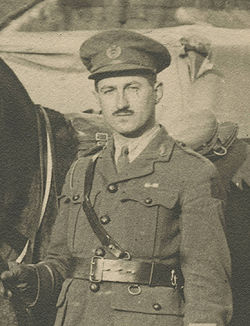Steel, William Arthur
| William Arthur Steel | |
|---|---|
| 3 November 1890 – 28 November 1968 | |
 | |
| Place of birth | Castleton Ontario |
| Place of death | Ottawa Ontario |
| Place of burial | Beechwood Cemetery |
| Allegiance | Canada |
| Service/branch | Canadian Army |
| Rank | Lieutenant-Colonel |
| Awards | MC |
Early Life
William Arthur Steel was born in Castleton Ontario to parents Reverand Thomas P Steel and Annie Anderson on 3 November 1890. He attended the University of Toronto and graduated in 1915 as an electrical engineer.[1]
Service
Steel was commissioned in the COTC in February 1916 and went with the 4th Canadian Divisional Signal Company to France in August 1916. In 1918 he became the Wireless Officer in the Canadian Corps Signal Company. For his service during the Great War where he was awarded the Military Cross[2] and was twice Mentioned in Despatches[3][4]
Following the War, Steel joined the Canadian Permanent Force as chief engineer of the Royal Canadian Corps of Signals, where he was responsible for the North West Territories radio system and for the air navigation radio system for Canadian civil aviation. During this time, working with General McNaughton, Steel helped to invent the Cathode-Ray Direction Finder[5], an early form of radar technology. During this period, he was also involved in producing such films as “To the Arctic” covering Lord Byng's trip to the North West Territories in 1925. On 17 August 1930, Maj W.A. Steel was promoted to lieutenant-colonel and seconded to the National Research Council in Ottawa where he served as the director of the National Research Council’s Radio Division until 1933. After, he was named commissioner in charge of engineering operations for the Canadian Radio Broadcasting Commission from 1933 to 1936.[1]
He retired from the military 1 November 1936 at the rank of Lieutenant Colonel. His retirement was not without controversy with respect to his pension. As he had been seconded to government duties, he had been receiving a salary significantly greater than his military one would have been. As pensions were calculated based on past years earnings, by retiring when he did he benefited greatly from his anomaly of service.[6]
Personal Life
Steel married Vera Ida Garland Mitchener on 15 September 1926 in York County, Ontario.
He had a passion for the game of tennis. In addition to being on the board of the Ottawa New Edinburgh Tennis Club in the early 1930s, he donated a trophy for men's doubles competition. He was the first president of the Ottawa Indoor Tennis Club in 1935 and later president of the Ottawa District Lawn Tennis Association from 1939 to 1941.[7]
After retirement he had a brief excursion in politics, serving as the secretary treasurer for W.D. Herridge’s New Democracy party. Steel went on to work as a consulting engineer on navigation and radar equipment in Ottawa, notable working on aircraft navigation tools and the construction of the DEW Line radar system.[1]
LtCol Steel died at the age of 78 on 28 November 1968 and is buried in Beechwood Cemetery.
Related Pages
- Down The MacKenzie to The Arctic with The Governor General
- Radio Forestry and Aircraft in Northern Saskatchewan
- The North West Territories Radio System (Canadian Defence Quarterly April 1927)
- The Work of The Royal Canadian Corps of Signals in the Field of Radio Communication in Canada
- Wireless Telegraph Communications in the Canadian Corps
Related Items
References
- ↑ 1.0 1.1 1.2 Beechwood Cemetery Historical Portraits Booklet - May 2015
- ↑ The London Gazette, Supplement 30716. 31 May, 1918. Page 5486.
- ↑ The London Gazette, Supplement 30107. 1 June 1917. Page 5426.
- ↑ The London Gazette, Supplement 31448. 8 July 1919. Page 8817.
- ↑ Canadian Patent CA251024 "Radio Direction Indicating System". The patent application was submitted 3 December 1924, three months before that of Robert Watson-Watt on the same design who is nevertheless publically credited for that same invention. Unfortunately, the Canadian patent was only published on 30 June 1925 and Robert Watson-Watt was therefore able to file in UK, France and Germany in a case of "simultaneous invention".
- ↑ "The Matter of a Pension". The Ottawa Journal, Novermber 9, 1936.
- ↑ Alan McCullough







